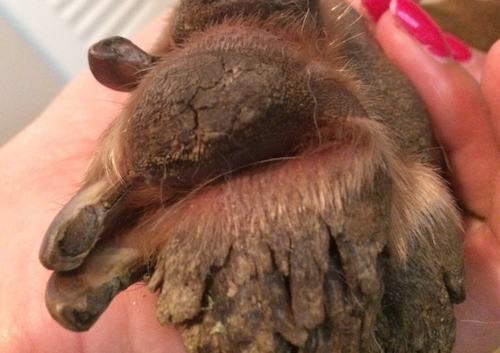

The manifestation of dried-out and "furry"-looking paws may make them prone to cracks. It can usually be found at the outer margins of a dog’s paw pads. The most common type of hyperkeratosis is paw pad hyperkeratosis, hence the name "hairy dog feet".
#HYPERKERATOSIS DOG PAWS TREATMENT SKIN#
Given the condition, the drying out of the areas of the skin where hyperkeratosis manifests may make them more susceptible to infection. There are also cases of the condition manifesting in a dog’s ears. It may also manifest at pressure points such as the elbows. Most commonly, the condition manifests in a dog’s paw pads or nose. Because of this, an imbalance in the keratinocytes' life cycle may pose problems. Keratin, being a protein filled with fiber, has an important role in the growth and development of hair, nails, hooves, claws, and the like.

To define the condition, hyperkeratosis in dogs is when the skin in areas such as a dog’s paw pads or nose becomes thick and hard due to a surplus of keratinocytes (the skin cells that are responsible for producing keratin), which fails to shed the way it should. Hyperkeratosis can be painful and uncomfortable for your dog, so it’s best to bring them to the vet for a proper diagnosis and treatment plan. While hyperkeratosis cannot be cured, uncomplicated cases have a good prognosis for management when treated with topical medications. Hyperkeratosis may be due to an underlying condition, or there may be no identifiable cause. It may also appear as part of aging in older dogs. However, the condition may also manifest on a dog’s nose, ears, or elbows.ĭogs of any age or breed may be susceptible to hyperkeratosis, but breeds such as Boston Terriers, Beagles, Boxers, Cocker Spaniels, basset hounds, and Labrador retrievers seem to be more susceptible to the condition. Also known as "hairy dog feet", the name describes the furry-like appearance of the paw pads, which is the area of the skin that is commonly affected. If you’ve ever noticed certain dogs having thick and hairy-looking paw pads or noses and wondered what it is, there’s a name for it.


 0 kommentar(er)
0 kommentar(er)
